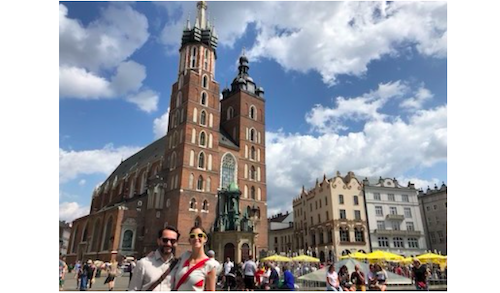Krakow, Poland, is truly a gem. We’ve been to Krakow multiple times, and yet, we are never tired of its magnificent main square, of the historical atmosphere of the old town, of its hearty food and welcoming people.
We had the perfect occasion to explore it again recently with Giulia’s parents. We spent 4 days in Southern Poland: 2 days in Zakopane (check out this gorgeous hike we did!) and 2 days in Krakow. With the experience we already had of Krakow, we were able to be fairly spontaneous in our sightseeing, while still maintaining some clever efficiency.
Here is our itinerary for 2 days in Krakow, to inspire you to see cool highlights, but without going crazy between attractions!
Introduction to Krakow
First of all, a little history and geography of Krakow (note that the Polish spelling is “Kraków” and the English one is “Cracow”, but Krakow is becoming more and more popular).
Krakow is located in Southern Poland, on the Vistula river; other touristic destinations nearby are Auschwitz-Birkenau concentration camp and Wieliczka Salt Mines.
It is the second-largest city in Poland and one of the oldest: it was actually the capital until 1596, and its university was established in 1364. Luckily, it was not damaged too much during World War II: great for art and architecture, not so great for the modern traffic that doesn’t fit in narrow streets! Krakow’s architectonical history can be experienced by moving from the old town out, towards the more modern districts.
In just a couple of days, we suggest you focus only on Krakow’s historic centre, which was included in the UNESCO World Heritage Site list in 1978. The historic centre includes the Old Town (in Polish: Stare Miasto), the Jewish quarter of Kazimierz, and Wawel Castle.
In this area, the architecture develops from Romanesque style to Gothic, Renaissance, and Baroque; there’s even a bit of Art Nouveau, from the times of the Austro-Hungarian Empire.
Let’s not forget about nature: at some point, you will certainly cross a section of Planty Park, the green ring that surrounds Old Town, created in the 1820s in place of the old city walls: a beautiful and relaxing area to walk through.
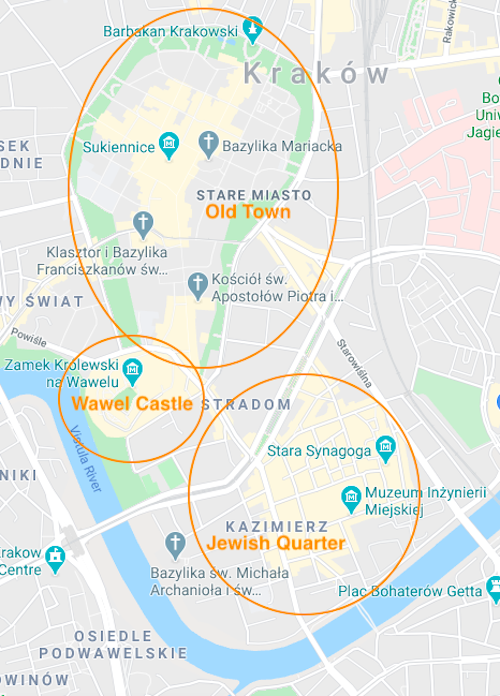
Map by Google Maps
Krakow day one
We arrived in Krakow in the early afternoon. After checking in at Nobilton Hotel, we decided to devote these first hours to getting acquainted with the Old Town.
Krakow main square, Rynek Główny
Start by reaching the heart of Krakow: Rynek Główny, the Main Square, one of the largest medieval squares in Europe (built in the 13th century). It’s really enormous: its sides are 200 meters long!
Many iconic buildings are located here, and most probably one of these three will be the first you will see: the Cloth Hall (Sukiennice) in the centre of the square, the 70-meters high Town Hall Tower (Wieża ratuszowa) next to it, or the unique St. Mary’s Basilica with its two Gothic towers different from one another.
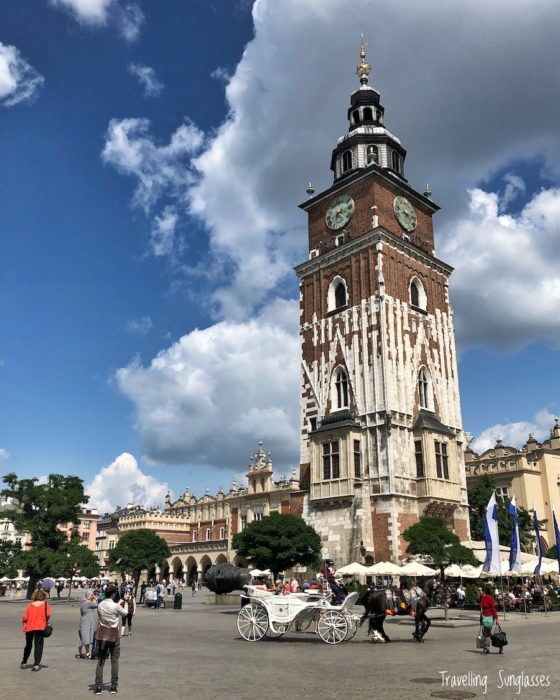
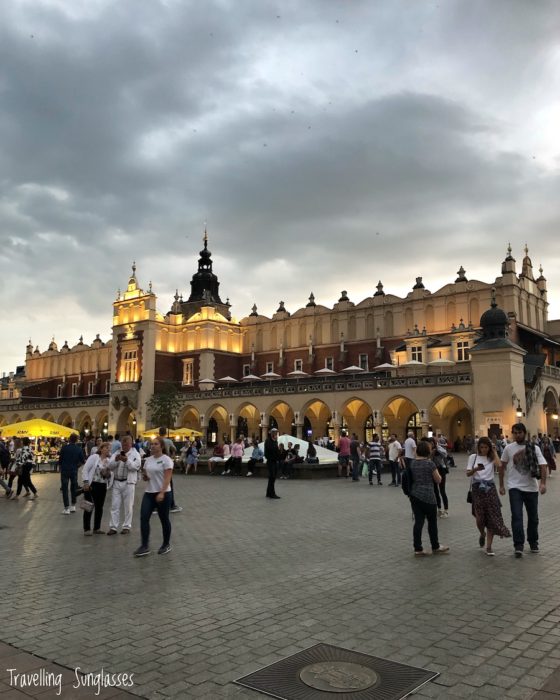
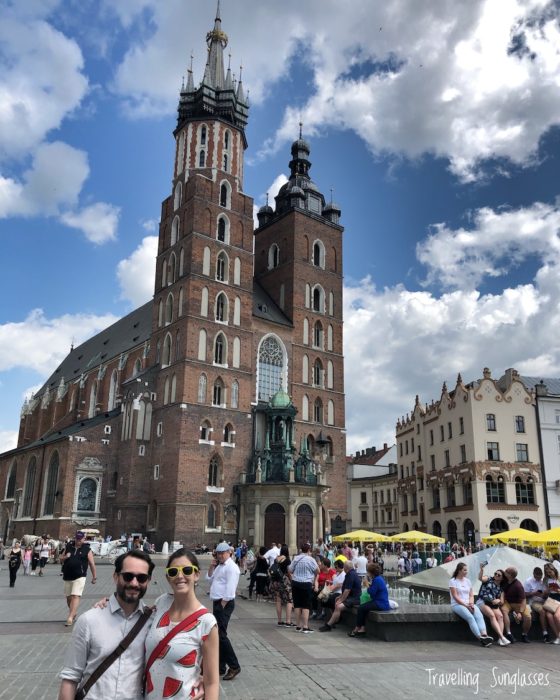
During your stay in Krakow, make sure you are at the square when the clock of St. Mary’s Basilica strikes the hour: from a window of the church tower, a trumpet player plays a signal called hejnał mariacki. According to the legend, as the Mongols attacked the city in the 13th century, a trumpeter sounded the alarm to warn the people; unfortunately, he was shot by an arrow in the throat, and could not complete his task. To this day, the trumpet player interrupts abruptly his tune, to commemorate his death.
Explore Krakow’s Old Town
Be spontaneous! No matter where you go, the picturesque streets of the Old Town will charm you. It feels like travelling in time, a few centuries back, between colorful facades, inns and taverns and the occasional church. One notable alley is Swietego Tomasza, where the bohemian society used to gather, now a very cute street crowded with restaurants.
Be efficient: take Florianska street, right by the Basilica, and make your way to the city walls. The iconic St. Florian’s Gate showcases pictures and paintings of local artists on both sides – extremely photogenic and instagrammable! Right outside it, have a look at the size of the fortified Gothic outpost of the Barbican: pure Medieval, crocodiles-in-the-moat style. Now it’s a tourist attraction and exhibition venue.
If you made it until here, you deserve a treat! Head through the park on the right: at the bottom of the under passage stairs to the other side of the Ring avenue, Stara Paczkarnia (map here) is an epic bakery of traditional Polish donuts “paczki”! Nothing fancy: bakers work behind the glass, ovens in the back, and a girl hands you out the precious donuts through a small window. They are the perfect combination of fluffy and firm, sweet but balanced, large and satisfying but light. We ate two each without thinking about it twice 🙂
One more reason to head to this side of the Old Town: the massive Słowacki Theatre (map here), built in 1893 in Baroque-Eclectic style, definitely deserves some attention.
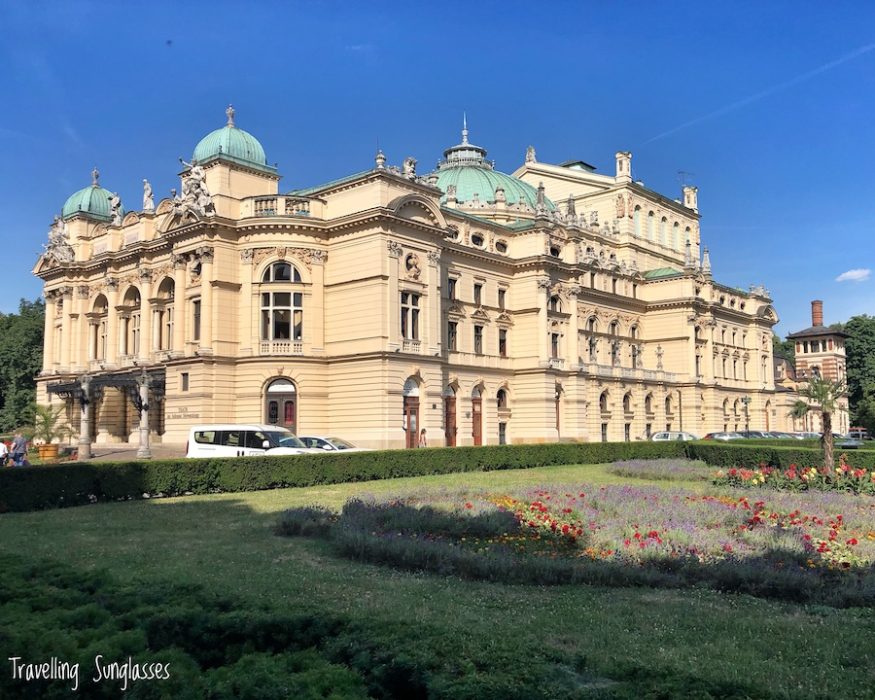
Krakow city tour
Now is the time to do a Krakow city tour. Normally we would do (and we recommend doing) a free tour, as we did in Oslo and Lisbon: they are perfect to learn about the city, meet fellow travellers, and support guides who are usually young and just starting their career.
However, this time we were travelling with my parents, so we spontaneously decided to hop onto a Melex golf kart by Gokrakow and do a 1,5-hour city tour with a private guide (we spent 300 ZL for the Old Town and Jewish quarter tour).
It was an excellent choice: even though the historic centre is quite small and easy to walk, the golf kart made it even more accessible. The recorded audioguide provided lots of information about streets, churches, theatres and important events. Furthermore, our guide was very knowledgeable and friendly, he answered all our questions and expanded on what we were interested in.
A unique experience in Krakow: classical music concert
Next up, my father’s passion: music! We attended one of the many Chopin concerts that are organized in concert halls (or in random apartments) in the old town. In case you didn’t know, Chopin was Polish!
The concert we attended was really nice, but I have to admit to dozing off after such a busy day of sightseeing. If it was just Darek and me, we would have probably chosen a different music genre.
Traditional Polish food in Krakow
Polish cuisine is rich, hearty and nutritious: we love it so much that we wrote about the best Polish food here!
If you get a chance to eat at a local market, do not hesitate: we headed back to Mały Rynek square, behind St. Mary’s Basilica, to try some traditional Polish food (and support the local community). Pierogi with different fillings, Oscypek cheese with jam, and even two slices of bread with lard and onion: Darek was proud of us 🙂
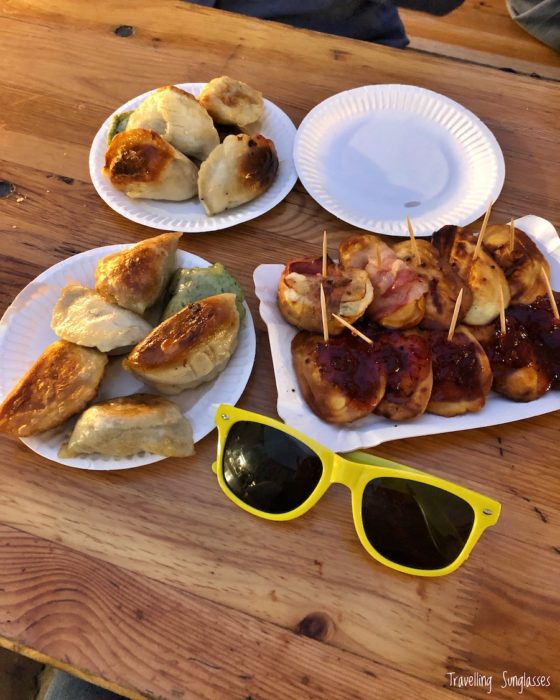
Krakow day two
On the second day of our Krakow itinerary, we set out to explore more of the historic centre, in particular Wawel Castle, the Jewish quarter, and of course any church that we would pass by.
Wawel Castle and Cathedral
Krakow Castle, called Wawel Castle, is truly spectacular: choc-full of interesting history, quirky architecture and decorations, and really fun to explore. We didn’t visit any of the permanent exhibitions, so we spent just 1 hour there, plus some 20 minutes in the Dragon’s Den.
Be efficient: Wawel Cathedral and Wawel Royal Castle are both located on Wawel Hill, but they are managed separately. Entrance to Wawel Cathedral is free, but there is a ticket for Sigismund Bell, the Royal Tombs and the Museum (find updated info on the official website). Walking around the Castle Hill is free, but there are separate tickets for each of the Royal Castle exhibitions (check them out here). Finally, there is a separate ticket for the Dragon’s Den, which is 5 ZL as of 2019/2020.
A short history of Wawel Castle
Like most European castles and royal palaces, the first remainings of this castle date back to the 11th century.
Over the centuries, it was expanded and modified considerably, especially from the 1300s to the 1600s: the Polish monarchs commissioned architects and artists from all over Europe (especially from Italy) to develop it from Gothic style to Renaissance, to Baroque.
Despite multiple fires, the Renaissance palace and courtyard have survived: monumental, bright and spacious. Sigismund Chapel, inside Wawel Cathedral, is an amazing example of Renaissance style.
Visit Wawel Castle
The entrance to the castle is to the North (Podzamce) through a red-brick gate. It already feels like travelling to the Middle Ages.
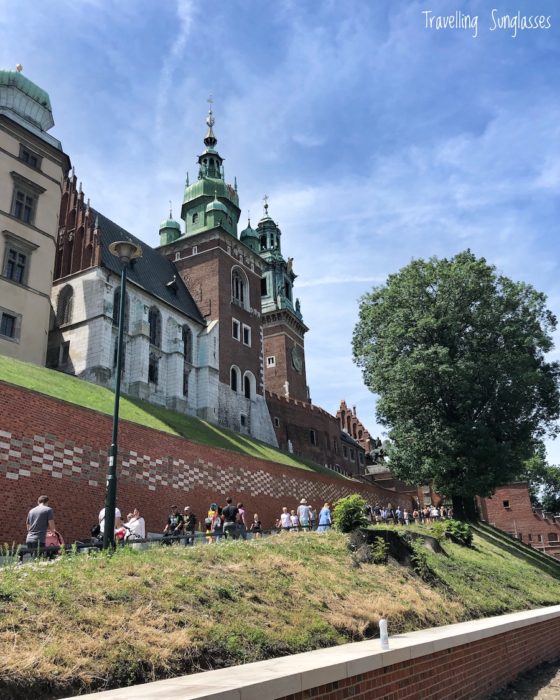
Next up, Wawel Cathedral is on the left (admission free). Look up before entering: the bones of the famous Smok Wawelski, the Wawel Dragon, are hanging at the sides of the door! Ok, fine, they are probably fossilized whale bones or mammoth bones. But then… What about the dragon cave under the hill? I choose to believe in the legend! 🙂
Wawel Cathedral is absolutely fascinating. The most remarkable feature is the interesting layers of architectural styles, one above the other. The structure is Gothic, dating back to the 1300s; however, the interior and the individual chapels were constantly updated, so that some are actually in Renaissance style (such as the Royal Chapel, called today Sigismund Chapel), and also Mannerist and Baroque.
Now, as you exit, raise your eyes to appreciate the impressive domes on the side of the church. They are so unexpected!
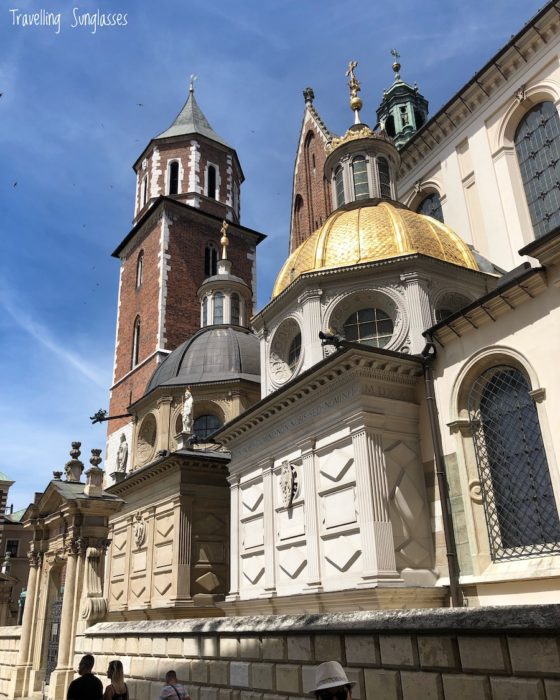
Be spontaneous! Keep wandering around and discover the nooks of the castle: the view of the church from the other side of the yard; the Renaissance courtyard; the statue of Pope John Paul II opposite the entrance to the Cathedral; the scale miniature model of the whole Wawel Castle in front of the info point.
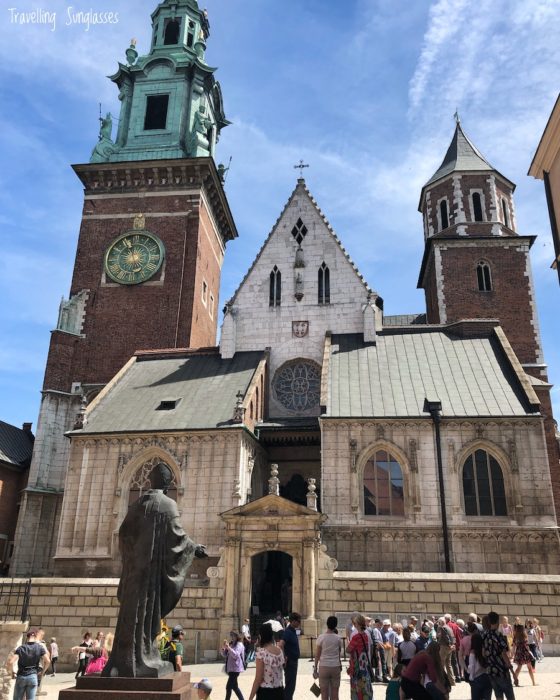
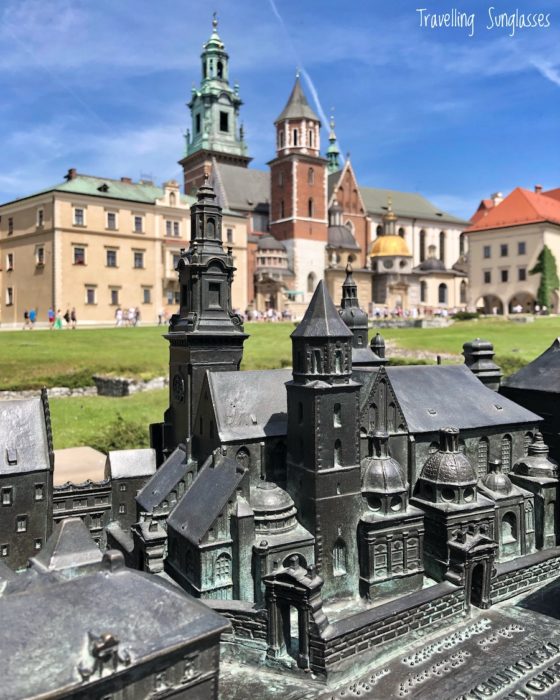
There are lots of these miniature models all over the centre!
Last but not least, make your way to the Dragon’s Den (map here, towards the river, South-West): one of the wall towers hides a spiral stair of 135 steps, which will take you to a fresh and mysterious cave.
Walk through it for a couple of minutes and behold: the famous statue of the Krakow Dragon is in front of you! Most probably, plenty of children will be trying to climb it while their parents take pictures.
Stick around: every 10 minutes, the dragon spits fire!
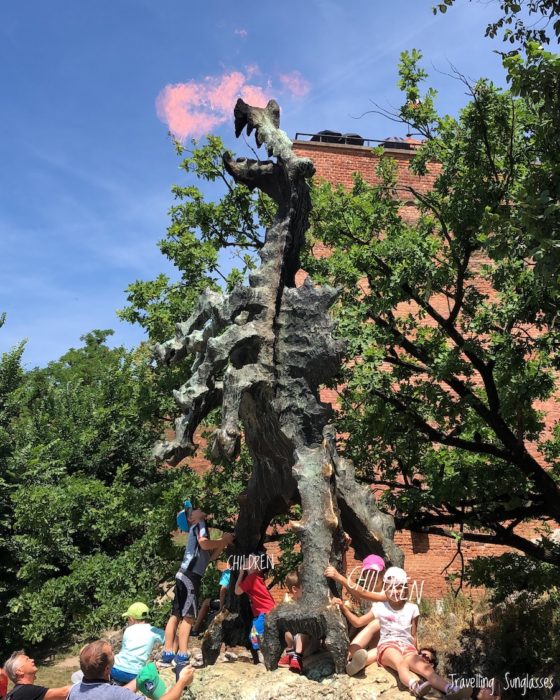
Kazimierz Jewish Quarter
Now that you’re already at the Southern end of the Old Town, keep walking and reach the Jewish District.
Krakow’s Jewish Quarter is called Kazimierz. It is located between Dietla Avenue/Park and the Vistula river; actually, Dietla Avenue is a filled-in branch of the Vistula.
When it was an island, it used to be a separate city called Kazimierz, after King Casimir III’s decision in 1335. Both Jewish and Christian Polish lived in this area for centuries: don’t be confused by the number of churches you will find in the Western side of the district. Still, it was the intellectual, cultural and spiritual capital of the Polish Jewish community, as testified by the number of Synagogues in the Eastern side of the district, towards Starowislna Street.
The beating heart of Kazimierz is Szeroka street (map), which is large enough to look like a square. Most attractions overlook the square or are close by: the Old Synagogue (the oldest in Poland, dating 1407), now also a museum; Remu Synagogue and cemetery (can you believe the Nazis turned the cemetery into a dumpster?); Popper Synagogue, established by a merchant, now not a synagogue anymore; and even the house where Helena Rubinstein grew up.
Even without visiting any of the museums, synagogues or churches, it’s worth to spend a little time to wander in Kazimierz: it is an artistic and bohemian district, perfect to discover vintage-looking restaurant and cafés, and memorials of the rich Jewish history and culture that developed here over the centuries. We walked around for approx. 1 hour.
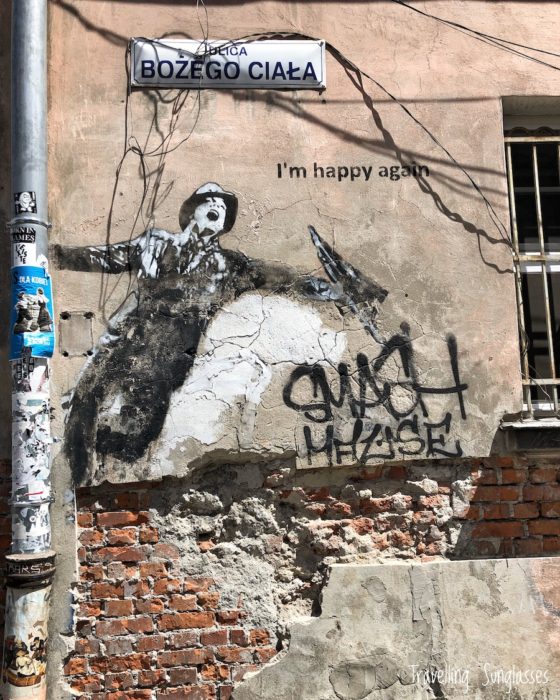
Kazimierz became famous especially after Steven Spielberg shot his film Schindler’s List here, in 1993; however, the ghetto where the Jews were forced to move to by the Nazis is Podgórze, across the river (where the factory is located).
Food-wise, the legendary location of the famous “zapiekanki” sandwiches is Plac Nowy square (map). Choose one of the unique kiosks, built in a round shape in the centre of the square, and buy one of these half-baguette-style sandwich topped with cheese and mayo. Perfect for a snack or even for a meal!
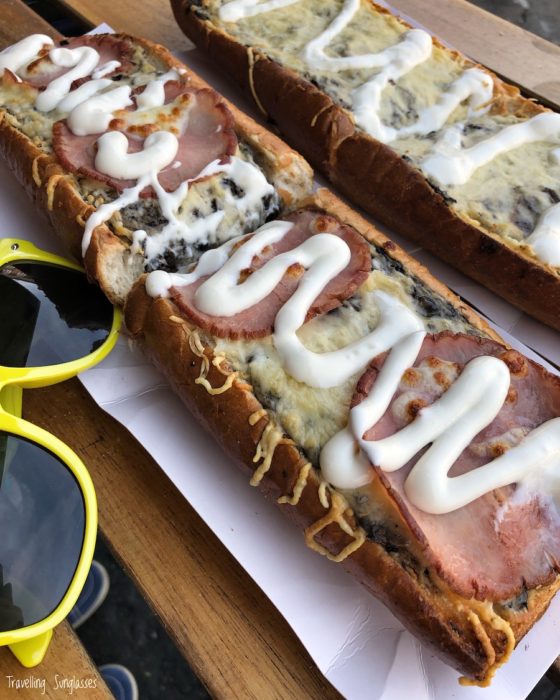
Churches in Krakow
Thanks to what we learned during the city tour, we went back to some of the attractions that piqued our interest. Most of them were churches! The architecture and the art contained in churches is always fascinating. In particular, we loved:
The Roman Catholic Parish Church of the Holy Cross, North-East in the Old town (map here) looks very unassuming from the outside. Inside, however, it is an engineering and architectural wonder: only one pillar holds up the palm vault of the main nave.
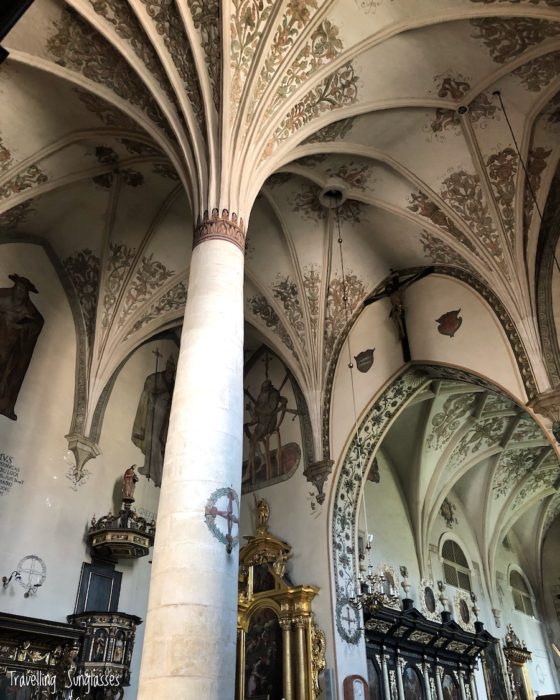
Church of the Piarist Fathers, dedicated to the Transfiguration of Christ, located North in the Old Town, close to the Barbican Tower (map here): its Baroque interior from the first half of the 1700s is just magnificent. The illusionistic polychrome technique makes the aisle look longer, the ceiling look higher, and paintings look like statues.
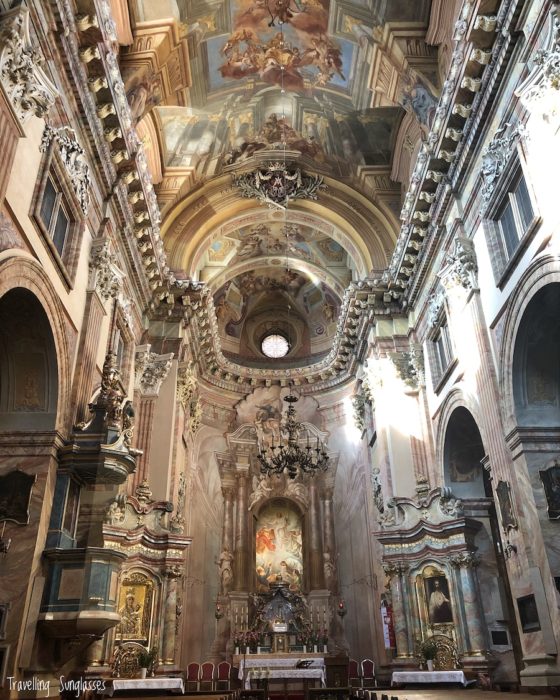
The Franciscan Church, located South-West in the Old Town (map here). Originally Gothic from the 13th century, it was refurbished several times: its flowery Secession-style interior decorations are remarkable, and the stained-glass window of God creating the world is just amazing.
Corpus Christi Basilica, located in Kazimierz Jewish district (map here) is remarkable because of its contrasts. The exterior is Gothic and stern, built of red bricks, and features a distinctive free-standing bell tower; but inside, below the high, raw, Gothic vaults, it is decorated with very rich Baroque altars, mostly black and gold.
Saint Peter and Paul Church, located on Grodzka street (the main street from the main square to Wawel castle, map here). You can’t miss it: lots of statues in front of its massive, white facade. This was the first Baroque church in Krakow. Sometimes there are classical music concerts there.
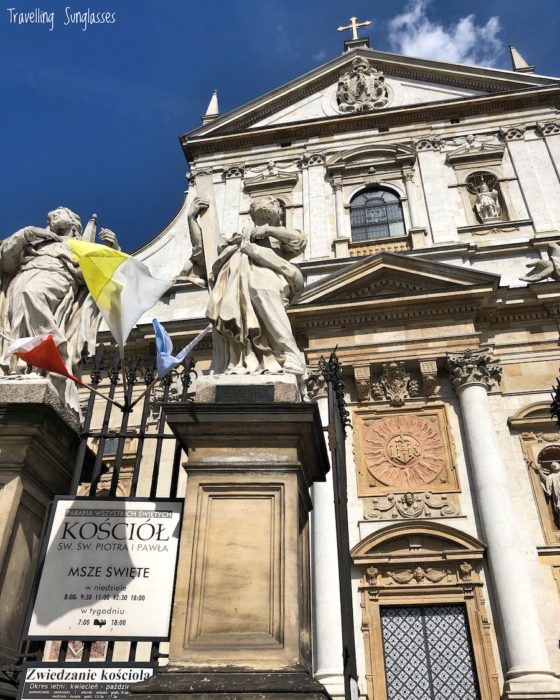
Traditional folk dinner with dances
Time for another Polish cultural experience. Earlier during the day, we booked the dinner and folk dance program at traditional restaurant Jama Michalika (476 ZL). It took place in a spacious room with a small stage, where the musicians played, and enough space in front of it for three singers/dancers.
During a delicious, traditional meal of soup, meat with vegetables, and cake, the performers kept us entertained with many Polish tunes and stories, picking guests to dance with them, twirling their colorful costumes. Even though we were very tired, it put us in a great mood and was really fun to watch.
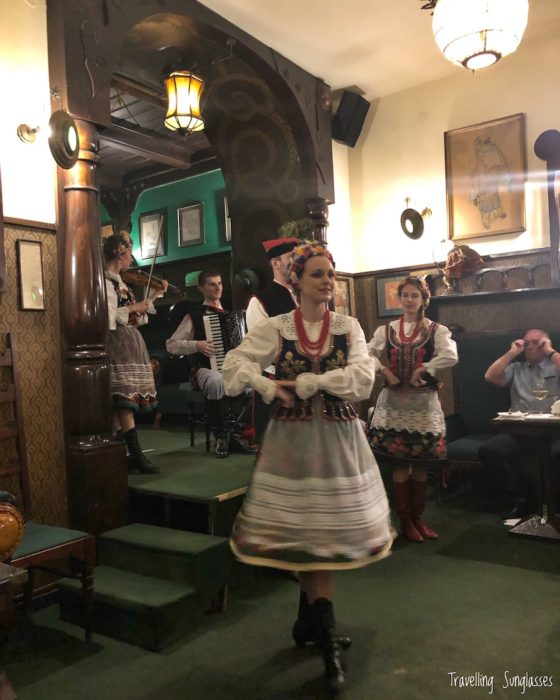
Krakow by night
All of the historic centre is even more charming by night, illuminated and magical. We went for a stroll down the now-familiar main road Grodzka, until the river Vistula.
We already glimpsed at it earlier during the day, but Father Bernatek’s Bridge (Kładka Ojca Bernatka, map here) by night really deserves some time. Its uniqueness are the circus-inspired statues hanging from cables in the centre, between the two walkways. Graceful and weightless, we walked back and forth for a while, admiring them and trying to capture them in pictures and video.
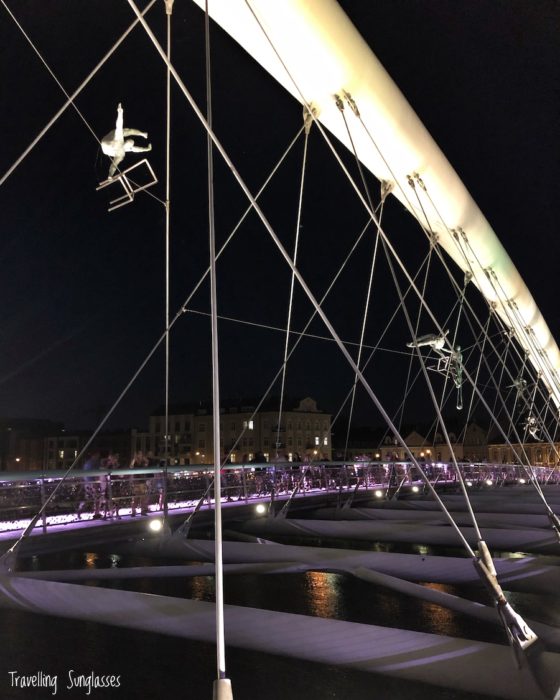
Conclusion on a 2-day itinerary of Krakow
Every time we leave Krakow, we wish we could spend there a few more days. There is so much more to visit and explore!
Have you been to Krakow, or are you planning to go there? Let us know in the comments! Cheers!
